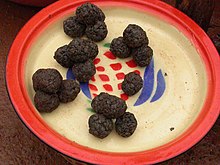




The cuisine of Senegal is a West African cuisine that derives from the nation's many ethnic groups, the largest being the Wolof, and is French-influenced. Islam, which first embraced the region in the 11th century, also plays a role in the cuisine. Senegal was a colony of France until 1960. From the time of its colonization, emigrants have brought Senegalese cuisine to many other regions.
Because Senegal borders the Atlantic Ocean, fish is very important in Senegalese cooking. Chicken, lamb, peas, eggs, and beef are also used, but pork is usually not due to the nation's largely Muslim population. Peanuts, Senegal's primary cash crop, as well as millet, white rice, sweet potatoes, cassava, black-eyed peas and various vegetables, are also incorporated into many recipes. Meats and vegetables are typically stewed or marinated in herbs and spices, and then poured over rice or millet couscous or eaten with bread.
Popular fresh juices are made from bissap, ginger, bouye (pronounced 'buoy', which is the fruit of the baobab tree, also known as "monkey bread fruit"), mango, or other fruit or wild trees (most famously soursop, which is called corossol in French).
Desserts are very rich and sweet, combining native ingredients with the extravagance and style characteristic of the French impact on Senegal's culinary methods. They are often served with fresh fruit and are traditionally followed by coffee or tea. Tea, known as attaya, is served in a ritualistic fashion.

